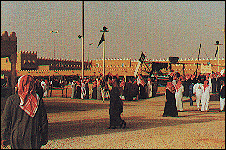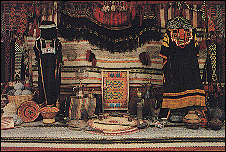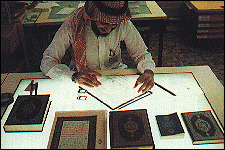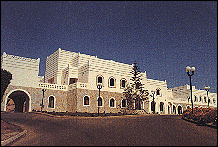 |
 |
|
|
|
||
|
||
| For thousands of years, the people of the Arabian Peninsula have been at the geographic, commercial and cultural crossroads of the world. As early as 3,000 B.C., the people of the western region of the peninsula were part of a far-reaching commercial network extending to south Asia, the Mediterranean and Egypt. The discovery some 1,900 years ago of the clockwork pattern of trade winds known as the monsoon, from the Arabic mawsim meaning reason, increased the importance of the peninsula. Trade flourished, with merchants of the peninsula acting as the vital link between India and the Far East on the one side and Byzantium and the Mediterranean states on the other. Interaction with other cultures of east and west over the centuries enriched the ancient traditions and culture of the people of the peninsula. |  |
|
|
The introduction of Islam to the Arabian heartland in the seventh century A.D. further strengthened the region's cultural heritage. Within a century, Islam spread west to the Atlantic Ocean and as far east as the Indian subcontinent and China. With Makkah as its core, the lslamic world witnessed a flowering of culture, the sciences and the arts unparalleled in human history. Every year for the past fourteen centuries, Muslim pilgrims from around the world have traveled to Islam's holiest sites in Makkah and Madinah, helping further enrich the culture of the people of the peninsula. With the formation of the modern Kingdom of Saudi Arabia in 1932, King Abdul Aziz Bin Abdul Rahman Al-Saud directed his efforts to preserving and perpetuating Arab traditions and culture. His legendary dedication to this cause was emulated by his sons and successors at a crucial time when the nation was entering an era of rapid economic development. That Saudi Arabia has successfully preserved and strengthened its cultural heritage while achieving the spectacular development and modernization of' the past two decades is testimony to the resilience of Saudi culture and the nation's determination to cherish and protect it. Today amid the bustle of 20th century life in modern Saudi society contemporary Saudi writers look to the past for inspiration. Popular musicians incorporate ancient rhythms and instruments into their modern music and painters capture traditional scenes. The accelerating pace of development in the 1970s, however, led Saudi leaders to take additional steps to preserve the nation's cultural and artistic heritage. In 1974 the General Presidency of Youth Welfare was established. One of its main functions is to strengthen an understanding and respect for the nation's culture and arts among the youth. In 1974. the Department of Museums and Antiquities was formed in the Ministry of Education. Today, in addition to the National Museum in Riyadh there are eleven museums throughout the Kingdom. Thousands of Saudis, particularly the younger generation, visit these museums daily to become better acquainted with their heritage. |
||
| CULTURAL INSTITUTIONS Saudi Arabia's emphasis on preserving its cultural heritage is facilitated by a variety of institutions throughout the Kingdom. First and foremost is the nation's education system. Already introduced by their families to Islamic and Arab values and traditions, young Saudis entering school are exposed to literature and the arts. Through their curricula and special events the schools instill in Saudi youths a deep respect for their past and love for their culture. The General Presidency of Youth Welfare (GPYW) sponsors a wide variety of cultural programs, including literary and drama clubs, |
 |
|
| folklore classes, library events, arts and crafts as well as science projects. In the drama clubs participants engage in writing competitions and dramatic performances as part of a team. The nine literary clubs throughout the Kingdom sponsor lectures and symposiums and encourage talented young writers. Similar clubs offer Saudis the opportunity to develop other artistic talents. The GPYW is also very active in national and international cultural events, such as poetry competitions, essay competitions, calligraphy and art exhibits to name a few. The organization sponsors a series of regular exhibitions, literary readings and symposiums at its regional offices and at its Riyadh headquarters. It also sponsors the participation of Saudis in international arts and cultural events. Another organization involved in arts and culture is the Saudi Arabian Society for Culture and Arts, which was founded in 1972 and is affiliated with the GPYW. Divided into six committees - cultural, theatrical, music and vocal arts folklore, arts, information and publishing - its mandate includes sponsoring Saudi artists and providing avenues for these new talents to develop and display their skills. In addition the society has established a library and an information center, as well as the Kingdom's first cultural center, located in Riyadh. The King Faisal Foundation promotes Arab and Islamic culture both within the country and abroad. The Riyadh-based organization awards an annual King Faisal International Prize to individuals who have promoted literature. The King Fahd Library in Riyadh has one of the largest collection of rare manuscripts on Arabic and Islamic literature and the arts and is a premiere research facility in the Middle East. Back to Top |
||
|
|
||
| TRADITIONAL DRESS AND JEWELRY Saudi Arabia's dress is one of its strongest ties to the past and reflects the challenging environment, faith and value of its people. The practicality of loose, flowing garments in a hot wind-swept climate was reinforced by the Islamic ideals of propriety dress and conduct. Today, as in antiquity, men wear a thawb, a simple, ankle length shirt of wool or cotton. Traditional headwear includes a ghutra, a large diagonally- folded cotton square worn over a kufiyyah (skull cap) and held in place by an igaal, a double-coiled cord circlet. A flowing floor-length outer cloak, known as a bisht, is generally made of wool or camel hair in black, beige, brown or cream tones. Back to Top |
 |
|
|
The woman's traditional dress displays regional and tribal motifs and is embellished with coins, sequins, metallic thread or brilliantly colored fabric appliques. The classic headdress is a.shayla - a scarf of black gauzy fabric wrapped around the head and secured by a variety of head circlets, hats or jewelry. An abaya, a black outer cloak, is customarily worn over the dress in public. Fine embroidery of clothes and the weaving of elaborately-designed textiles have also been long practiced in the peninsula. Designs used in tent coverings saddlebags and carpets vary from region to region. Jewelry has been an essential element of Arabian dress for thousands of years. Typically made of silver or silver alloy, traditional bracelets, rings , necklaces and head ornaments are characterized by their impressive size, bold designs and hand-crafted appearance. The jewelry is often embellished with semi-precious stones, corals, beads and coins. adorning the interior walls of mosques, as well as public and private office buildings and homes |
||
|
|
||
CALLIGRAPHY Arabic calligraphy dates back approximately 1,400 years to the first century of Islam. Historically, the primary subject matter for calligraphy has been the Holy Qur'an. Characterized as the quintessential Islamic art form, calligraphy is a revered art in Saudi Arabia. Saudi museums collect and display rare manuscripts and other organizations commission works of calligraphy, provide training in the art form, and hold competitions to foster a new generation of young artists. Today, calligraphy is a dominant theme in metal work, ceramics, glass, textiles, painting and sculpture throughout Saudi Arabia. Inscriptions can be found Back to Top |
 |
|
|
|
||
| ARCHITECTURE As a part of the Kingdom's interest in preservation, contemporary Saudi architects are increasingly using traditional Islamic concepts in building designs. Historically, building designs and materials were dictated by the climate, geography and resources of the various regions. Adobe was a mainstay of traditional builders in Riyadh, the Najd and parts of the Eastern Province due to its malleability, availability and insulation qualities. In western Saudi Arabia stone and red brick are common construction materials. In Jeddah, coral taken from the Red Sea reefs is used. |
 |
|
|
Today Saudi architects have been instrumental in preserving the Kingdom's architectural integrity, as well as in revitalizing traditional building designs. Utilizing elements of traditional architecture in the design of new structures strengthens the link between the country's architectural past and its innovative future. Researchers at various universities, such as the King Faisal University, analyze and draft suggestions for the architectural development of various regions throughout the Kingdom based on studies of traditional architecture. King Saud University and the King Khalid International Airport are two striking examples of just how well traditional Islamic design and modern structure can be combined. The efforts of the government and local organizations have resulted in the preservation of Saudi Arabia's rich heritage and a greater appreciation among young Saudis that promises to ensure that the Kingdom's cultural and artistic treasures will be cherished by future generations. |
||